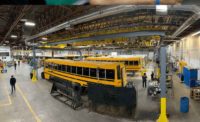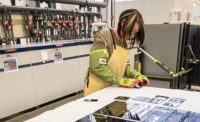Automation has long been touted as a key enabler of reshoring. Because automation can produce more with less, it can help domestic manufacturers compete with low-cost overseas labor.
It’s certainly a valid premise. But, like golf, dancing, baking bread or cutting dovetails by hand, implementing automation is harder than it looks.
Tool manufacturer Stanley Black & Decker (SBD) learned that lesson earlier this year. In March, the company said it will close its factory in Fort Worth, TX, just three years after it opened in 2020. As part of an overall restructuring plan, SBD will discontinue operations in Fort Worth and transfer its Cheraw, SC, operations to facilities in Jackson and Gallatin, TN.
The closing of the Fort Worth facility will result in the loss of 175 employees. The company will also cut 182 employees in South Carolina, while adding 80 jobs in Tennessee. The closure and consolidation are part of a strategy aimed at saving $2 billion. While SBD has reported strong revenues, including $16.9 billion in 2022, it has been dealing with supply chain and consolidation issues over the past few years, according to a presentation on earnings from the company.
The Fort Worth plant made Craftsman tools, including sockets, ratchets and wrenches. When SBD acquired Craftsman back in 2017, it hoped to “revitalize this iconic U.S. brand and bring back its American manufacturing heritage.”
Automation would be part of the company’s strategy to bring production of the tools back to the U.S. In a 2019 press release announcing the Fort Worth plant, SBD said the factory would leverage the most advanced manufacturing technologies available to optimize productivity and sustainability, including pre-flattening steel technologies to improve material yield by almost 25 percent, as well as water and energy management technologies to reduce resource consumption.
“This new plant will [use] state-of-the-art manufacturing technologies and demonstrate our commitment to becoming one of the world’s leaders in advanced manufacturing,” predicted Jim Loree, then the president and CEO of SBD. (Loree retired last summer after 23 years with the company.)
It didn’t work out that way. The factory was slated to be in production 18 months after the groundbreaking. However, the pandemic and supply chain challenges delayed those plans, and deficiencies with the technology intended to automate various manufacturing processes prevented the plant from ever reaching full capacity.
The factory struggled to achieve production goals. Attrition among experienced tool-making experts and turnover within Stanley’s tool division further contributed to the factory’s struggles. The absence of seasoned employees with deep knowledge of the manufacturing process hindered problem-solving efforts.
“Stanley Black & Decker’s experience with the Craftsman factory in Fort Worth offers a sobering reminder that advanced automation is not a one-size-fits-all solution to the complexities of modern manufacturing,” says Robert Little, president and general manager at ATI Industrial Automation, a manufacturer of robotic tool changers and other peripherals. “While the goal of creating a highly automated, efficient and domestic manufacturing facility was admirable, the practical difficulties of implementing such a system were underestimated, revealing an important lesson: Technology can enhance efficiency and productivity, but it cannot fully replace the nuanced expertise of seasoned human workers.
“It’s crucial to strike a balance between leveraging automation for efficiency and retaining the irreplaceable craftsmanship that experienced professionals provide. Additionally, reshoring operations is not merely about bringing jobs back home; it involves navigating logistical, cultural and operational challenges that demand careful planning and execution.”
Sean Dotson, PE, former president and chief technology officer of systems integrator RND Automation, concedes that there are many reasons why SBD closed the Fort Worth plant, but he also says that manufacturers can learn some lessons from what happened.
For example, Dotson questions SBD’s decision to use an automation company out of Eastern Europe. “Automation only works when the company stands behind it and can fix issues quickly when they arise,” he says. “Perhaps the overseas location was one issue?”
He also questions the company’s timetable. “The system was rushed and not fully tested before it was installed,” he points out. “That’s a guaranteed way to fail at automation. This is the golden rule: Always test the system before it leaves the machine builder. If you don’t, you are going to have a bad time.
“The company’s timetable of 18 months to automate a factory—during COVID—was aggressive. Rushing it was likely one of the reasons the system wasn’t fully tested.”
To be fair, SBD is, indeed, a leader in advanced manufacturing. The company operates some 100 manufacturing facilities worldwide. At least five are implementing advanced technologies, including manufacturing execution systems, 3D printing, virtual reality and artificial intelligence. The company’s DEWALT assembly plant in Charlotte, NC, is a model of quality and efficiency.
The company also operates an Advanced Manufacturing Center of Excellence, called “Manufactory 4.0,” in Hartford, CT. The facility is the focal point of the company’s global Industry 4.0 “smart factory” initiative, housing a team of approximately 50 Industry 4.0 experts focused on accelerating the company’s adoption of advanced manufacturing technologies and creating programs to prepare the company’s workforce for today’s digital manufacturing environment.
SBD’s experience demonstrates that even experienced manufacturers can stumble with automation. Recounting the tale is not intended to discourage companies from automation, but rather to invest in technology wisely, get local help, and set realistic expectations.



